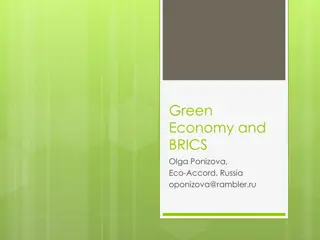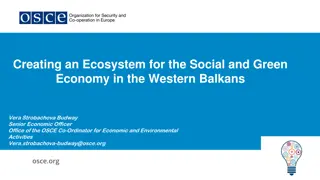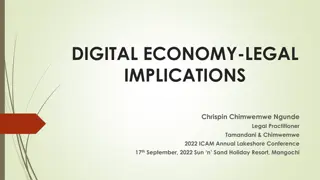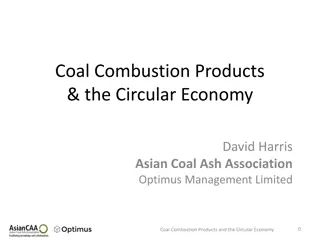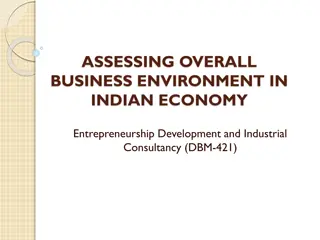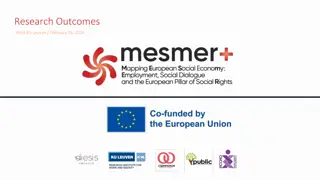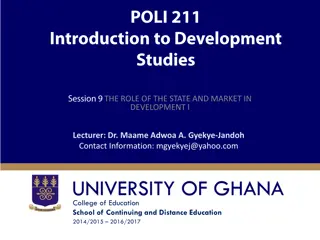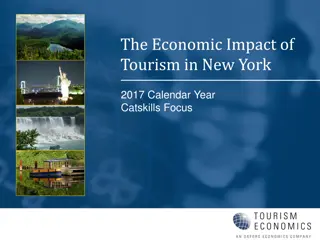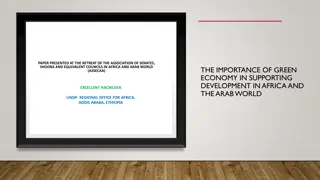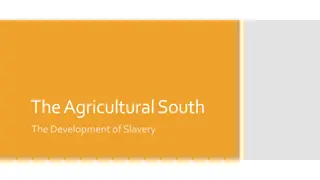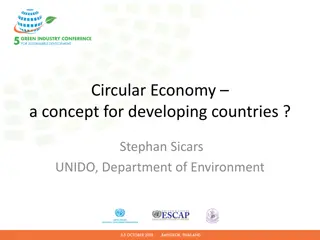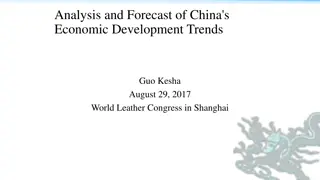Update on the State of the Economy and Development Strategies
The presented update covers the state of the economy, development of successor medium-term plans, sector strategies, and states' GDP computation. It includes discussions on economic projections, global trends, domestic economic challenges, and key indicators like GDP growth, unemployment, and inflation rates. Emphasis is placed on the importance of strategic planning at national and state levels for economic transformation.
Download Presentation

Please find below an Image/Link to download the presentation.
The content on the website is provided AS IS for your information and personal use only. It may not be sold, licensed, or shared on other websites without obtaining consent from the author. Download presentation by click this link. If you encounter any issues during the download, it is possible that the publisher has removed the file from their server.
E N D
Presentation Transcript
UPDATE ON THE UPDATE ON THE STATE OF THE ECONOMY, STATE OF THE ECONOMY, DEVELOPMENT SUCCESSOR MEDIUM TERM SUCCESSOR MEDIUM TERM PLAN, SECTOR STRATEGIES STATES PLAN, SECTOR STRATEGIES STATES STRATEGIC PLANS AND STATES GDP COMPUTATION STRATEGIC PLANS AND STATES GDP COMPUTATION DEVELOPMENT OF OF Presented at the Joint Planning Board (JPB) Meeting Holding in Kano, Kano State By Tunde Lawal Director, Macroeconomic Analysis Ministry of Budget and National Planning Tuesday, August 23, 2016
Outline Outline 1.0 Introduction 2.0 State of the Economy 3.0 Road Map for Development of Successor Medium Term Plan 4.0 Milestones Attained on the Development of Successor Medium Term Strategic Plan 5.0 Medium Term Sector Strategies and States Plan 6.0 States GDP Computation Project 7.0 What Role for States? 2
1 1.0 .0 Introduction Introduction The development of Successor Medium Term Strategic Plan (MTSP), other Sector Strategies, States Plan and States GDP Computation Project Due to the importance attached to the development and implementation of MTSP the following decisions were reached at the JPB meeting in Awka in October 2015: Need to provide an update on the State of the economy States were also encouraged to develop their medium term development plans, taking a cue from the National Strategic plan To ensure that there is effective linkage between plans and annual budgets It was also agreed that States and Sectoral MDAs should develop their strategic plans and sector strategies The States GDP computation was also identified as a key project that needs to be implemented to facilitate rapid transformation of the economy The purpose of this presentation is to update you on the State of the Economy, activities implemented to develop MTSP, other sector strategies and computation of States GDP 3
2.0 2.0 State of the Economy State of the Economy Global GDP projection for 2016 has been downgraded in WEO, July 2016 from 3.2% in April to 3.1% due to the outcome of UK vote (Brexit) which surprised global financial market International Oil Price movement ranged between US$31.7/b in February and US$50.96/b in Aug 19, 2016 as against US$48.86 in Oct 2015 Domestic economic downturn continued with GDP growth at -0.36% in Q1 of 2016 compared with 2.11% in Q4 of 2015 - There are strong indications from NBS that Q2 may end in negative. This suggests that the country is technically in recession Unemployment rate increased from 10.6% in Q4 2015 to 12.1% in Q1 of 2016 - Under employment rate rose from 18.7% to 19.1% during the period Headline inflation trended upward to 16.5% as at June 2016 compared with 9.39% in September 2015 Exchange rates at the interbank and BDC stood at $1/N231.76 and $1/N351.82 a dollar in June 2016 respectively from N196.99 and N258.3 in December 2015 account to all tiers of Government from October 2015 to date - Creating challenges for some States in paying salaries - Leading to of the Federal Government s decision to grant bail out facilities to the States and the current effort at supporting the States Exports declined by 34.6%, while imports dipped by 7.8% in Q1 of 2016 Significant reduction in the size of distributable revenue from the pool 4
2.0 2.0 State of the State of the Economy.../2 Economy.../2 As a response government has committed to fiscal reforms which center on fiscal discipline and expanding the non oil revenue base - Sub-National Governments have been encouraged to focus on their potentials for increased independent revenues - Mobilizing non-oil revenue to increase fiscal space - Removing impediments to growth (weak business environment) Of the total budget of N6,060.68 billion, N2,123.2 billion (35%) has been spent by FG Capital budget released to MDAs for their utilization amounted to was N253 billion as at July 18, 2016 - When you add the share of capital in statutory transfers, it is N331.58 billion On the Private Sector and Banking Side, the aforementioned developments contributed to: On the Private Sector and Banking Side, the aforementioned developments contributed to: - Increased investment uncertainty - Slowdown in the corporate sector which is affecting credit quality and NPLs are rising - Asset quality have deteriorated and banks are vulnerable to credit and concentration risks - Banks have increased their exposure to government, reflecting lower risk appetite 5
2.1 2.1 Some Policy Responses and Some Policy Responses and Achievements Designed SIP to address the highlighted challenges and also direct the trajectory of the national economy towards the path of sustainable development and inclusive growth Removing Supply Constraints with introduction of flexible foreign exchange regime and PMS Deregulation leading to availability of the product throughout the country and reduction in PMS loading from 1,600 trucks per day to 850 trucks per day Achievements Government has commenced the process of ensuring that Nigeria is self-sufficient in food production which is being done through the instrumentality of the CBN Anchored Borrowers Programme in the States - With interest rate of 9% Investments in Petrochemical complexes by Dangote when completed in 2019 and completion of $150 million investment of Indorama in fertilizer export plan. But investments will help share up foreign exchange earnings in the country Golden in Sunti, Niger State has commenced production of brown sugar; Savanah sugar in Numan has increase its raw sugar production from 6,600 to 12,200 metric tons Increase in the economic activities of the North East due to improved security Low interest lending to the Private Sector particularly the MSMEs Protection and creation of jobs by eliminating Ghost workers, supporting States to pay salaries, and use of Social intervention for direct job creation and prioritising capital releases for infrastructure, agriculture and transportation 6
2.1 2.1 Some Policy Responses and Some Policy Responses and Achievements...2 Implementation of social investment programme has commenced and this is being implemented by the Federal Government in close collaboration with States Achievements...2 Recent Signing of Agreements with 14 Solar companies, which is expected to add 1,125 mega watts to the National Grid Government has committed to reforms which center on monetary policy adjustment - Recent adjustments more closely aligns the IFEM rate with FX supply and demand which should help ease the pressures on external reserves - Ensuring FX policy restores confidence (foreign capital) and promotes growth 7
3.0 Proposed Roadmap for Development of the MTSP Development of the MTSP is on course Key activities in the road map include: Technical Working Groups Meetings Draft Working Visits Macroeconomic Framework Development of 2017-2019 MTEF Inauguration of TWGs Zonal Validation Workshops Leadership Buy-In Consultation with NASS Internal Consultative Sessions with HOSF and Body of Perm Secs and other Partner MDAs Development of 2017 Budget Appointment of Coordinating Consulting Firm Presentation of Draft Plan to NEC Implementation and M & E Framework Presentation of draft Plan to FEC Engagement with EMT, NEC, FEC Development of MTSS/Sector Plans (Currently on going) Finalization of Plan Printing and Dissemination of Approved Plan Approval and Launching of the Plan
4.0 4.0 Milestones Attained on the Development of Milestones Attained on the Development of Successor Medium Term Strategic Plan Medium Term Strategic Plan Successor Obtained leadership buy-in to commence the development of the MTSP The macroeconomic framework and policy thrust of the MTSP has been developed - Formed the basis for developing 2017-2019 MTEF and 2017-2019 MTSS - Made presentation of draft Macro Framework, policy thrust for the MTSP to HOSF and Body of Federal Perm Secs Engaged consultants to train and work with MDAs on Sector Plans The States are also being encouraged to Develop their State Plans and mainstreaming of SDGs into the States Planning and Budgeting Process
5.0 5.0 Sector Sector Strategies and Strategies and States Strategic Plans Commenced the process for developing the Medium Term Sector Strategic (MTSS) at the Federal level States Strategic Plans Held sensitization workshop on MTSS 2017 2019 with the Permanent Secretaries and Heads of Federal Government (FG) Agencies on August 15, 2016 The workshop focused on sensitising PSs, DGs and there Directors of PRS on the approach to be adopted for developing the MTSS to ensure effective allocation of scarce resources for maximum benefit to all citizens Constituted Sector Planning Teams (SPTs) under the leadership of the Hon. Ministers and Permanent Secretaries of the pilot (14) high spending Ministries Provide technical support and advice to SPTs to ensure the formulation of credible MTSS with assistance from UK Department for International Development (DFID) Developed Planning Tools for the costing and prioritisation of MDAs projects into the MTSS/Sector Plan Organized a two-day training sessions for SPTs of on 18th 19th August, 2016 Next step is to organize a one-week intensive training for pilot Ministries with technical support from MBNP and DFID starting from August 29 2016 for the development of MTSS for 14 high spending Ministries Finalised plan to train and conduct rapid appraisal of projects and programmes for the remaining MDAs to feed into their 2017 Budget and 2017-2020 Plan Finalisation of MTSS preparation is early September 2016 Efforts should be made to ensure that MTSS of MDAs are linked to the strategic sector objectives and the overarching national development goals
6.0 States GDP Computation Project Resolutions reached on SGDP Computation Project at Awka, Anambra State include: Resolved that the project should be concluded in the States that had made their financial contributions, while States that were yet to pay should be encouraged to do so; and MBNP should endeavour to sensitize the State Governors on the benefits of the project using the platform of the National Economic Council (NEC) and advocacy visits The implementation of the second phase of the exercise to cover all the states (including pilot States) that have made the mandatory payment of N14.1m - This is to allow for the impact of the rebasing and other states peculiarities to be captured - Although NBS has started preparatory works for the exercise, including conducting training the trainers programme for the statisticians of the 22 States + FCT - Funding challenge remains & constrain Only 22 States and FCT have so far paid, leaving a balance of 14 States yet to pay - These include Abia, Adamawa, Benue, Borno, Edo, Imo, Katsina, Kebbi, Kwara, Nasarawa, Plateau and Zamfara The remaining States and FG are urged to make their contribution
7.0 7.0 What Role for the States? What Role for the States? States that are yet to commence the process of development of Medium Term Plans should do so and be guided by the 2017-2020 macroeconomic framework and Policy Thrust We would encourage a strong partnership from States towards the development and implementation of the MTSP State Governments should explore creative ways to financing its expenditure for 2016 and 2017 budget Efforts should be made to plug leakages, reduce cost of governance and ensure efficient resource allocation States are encouraged to also explore innovative financing options (including boosting IGRs) to complement their revenue share from the FAAC States are also urged to fast-track the process of developing their medium term strategic plan Need for the remaining 14 States to make payments for the computation of State GDP - At the State and Federal levels - States need to diversify their productive base and IGR Need to make tough choices and begin to do things differently States and LGAs are expected to invest significantly in the economy to return the country on the path of high growth and sustainable development 12



